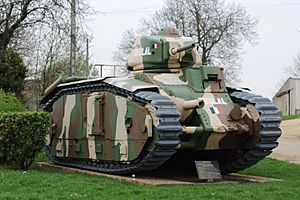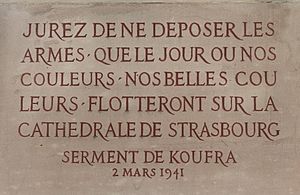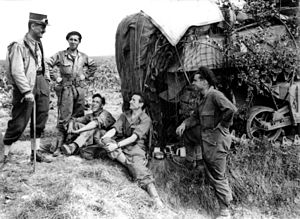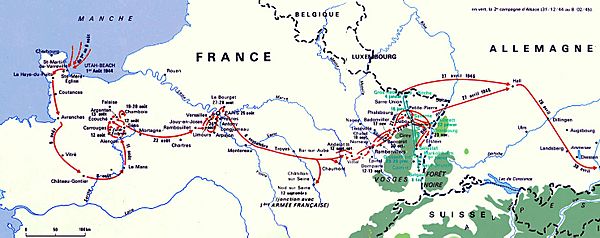Philippe Leclerc de Hauteclocque facts for kids
Quick facts for kids
Marshal
Philippe Leclerc de Hauteclocque
|
|
|---|---|
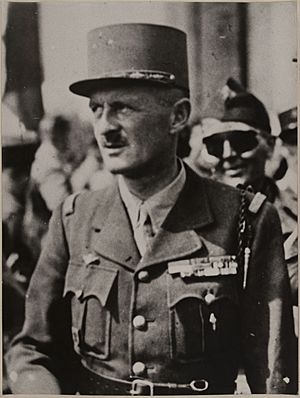
Leclerc in August 1944 during the Liberation of Paris
|
|
| Member of the Superior Council of Defence | |
| In office 12 April 1947 – 28 November 1947 |
|
| Personal details | |
| Born | 22 November 1902 Belloy-Saint-Léonard, France |
| Died | 28 November 1947 (aged 45) Colomb-Béchar, French Algeria |
| Resting place | Les Invalides |
| Spouse | Thérèse de Gargan |
| Children |
|
| Parents |
|
| Alma mater |
|
| Nickname | Leclerc |
| Military service | |
| Allegiance | Third Republic Free France Fourth Republic |
| Branch/service | French Army |
| Years of service | 1924 – 1947 |
| Rank | Army general |
| Unit |
List
|
| Commands |
List
|
| Battles/wars |
List
|
Philippe François Marie Leclerc de Hauteclocque (born November 22, 1902 – died November 28, 1947) was a brave French general during World War II. He became a Marshal of France after he died in 1952. In France, people often call him simply le maréchal Leclerc or just Leclerc. He is famous for leading his troops across Africa and helping to free Paris during the war.
Contents
Early Life and Military Training
Philippe de Hauteclocque was born on November 22, 1902, in a small town called Belloy-Saint-Léonard in France. He came from an old noble family with a long history of serving in the military. Many of his ancestors fought in important battles throughout French history.
Philippe was homeschooled until he was 13. Then, he went to a Jesuit school and later to a special preparatory school. In 1921, he joined the École spéciale militaire de Saint-Cyr, which is France's main military academy. He graduated in 1924 and chose to join the cavalry, which meant he would serve with horse-mounted soldiers. He then went to the Cavalry School in Saumur and graduated at the top of his class.
In 1925, Philippe married Thérèse de Gargan. They had six children together. He was a very devoted Catholic.
Service in Morocco
After his training, Leclerc served in Morocco, which was a French territory at the time. He was promoted to lieutenant in 1926. He worked as an instructor at a military academy and later fought against local guerrillas in the Atlas Mountains. He was very brave, even having two horses shot from under him in one battle.
In 1933, he was recognized for leading an attack on enemy caves. He was promoted to captain in 1934, which was quite fast for that time. He also received the Legion of Honour, a very important French award.
In 1936, he broke his leg after falling from his horse. He always took responsibility for his mistakes and taught his soldiers to do the same. In 1938, he attended the French Army's staff college, preparing him for higher command.
Fighting in World War II
The Fall of France
When Germany invaded France in May 1940, Leclerc was a staff officer in the 4th Infantry Division. His unit was surrounded by German forces. Leclerc managed to escape by pretending to be a civilian refugee. He was captured but convinced the Germans he was not a soldier and was released.
He rejoined French forces and was wounded in the head during a German air attack. He was captured again but escaped by jumping out a hospital window! After France signed an armistice with Germany, Leclerc decided he would not give up. He wanted to continue fighting. To protect his family, he started using the name "Leclerc" so his real name wouldn't appear in the news. He traveled through Spain and Portugal to reach Britain.
Joining the Free French
Leclerc arrived in London in July 1940 and met with General Charles de Gaulle, who was leading the Free French Forces. De Gaulle quickly saw Leclerc's talent and promoted him. Leclerc wanted to join the largest Free French unit, the 13th Foreign Legion Demi-Brigade, but was turned down.
Instead, in August 1940, de Gaulle sent Leclerc to French Equatorial Africa (a group of French colonies in Africa). Leclerc became the governor of French Cameroon. He worked to make sure these colonies supported the Free French cause. He then led his troops against Gabon, another French colony whose leaders supported the Vichy French government (which cooperated with Germany). The Battle of Gabon ended with Gabon joining the Free French.
The Oath of Kufra
From Chad, Leclerc led daring raids into Italian Libya, which was controlled by Italy, an Axis power. In February 1941, his forces captured Kufra, an Italian outpost deep in the desert. After this victory, Leclerc made his men swear a famous oath, known as the Serment de Koufra ("Oath of Kufra"):
You shall not lay down arms, until the day when our colours, our beautiful colours, flutter over the Strasbourg Cathedral.
This oath meant they would fight until the French flag flew again over Strasbourg Cathedral, a city in France that Germany had taken. This showed their strong determination to free France. Leclerc learned a lot about fighting in the desert and was awarded the British Distinguished Service Order. He was promoted to general in August 1941.
In 1942, Leclerc led a larger force from Chad into Libya. They captured several towns and reached Tripoli in January 1943. His troops, known as L Force, then helped the British Eighth Army in their advance into Tunisia, fighting against German forces.
Liberating France
The 2nd Armored Division
After the fighting in North Africa, Leclerc's L Force was transformed into the 2nd Armored Division (2e DB), often called La Division Leclerc. This division was equipped by the Americans and included soldiers from various backgrounds, including those who had fought for Vichy France. Leclerc worked hard to unite them into a strong team.
In April 1944, the 2e DB was sent to Britain to prepare for the Allied invasion of northern France, called Operation Overlord. Leclerc trained his troops in Yorkshire, England.
Normandy and Paris
On August 1, 1944, the 2e DB landed at Utah Beach in Normandy, France. They fought alongside American forces in the Falaise Pocket, a major battle that trapped many German soldiers.
Leclerc's division had a very special mission: to liberate Paris. Allied troops initially planned to bypass Paris to avoid destroying the historic city. However, when Parisians rose up against the Germans, de Gaulle and Leclerc convinced General Dwight D. Eisenhower to send the 2e DB into the city. Leclerc's men fought their way into Paris, and on August 25, 1944, the German commander surrendered to Leclerc. This was a huge moment for France. The next day, de Gaulle led a triumphant parade through Paris, with Leclerc by his side.
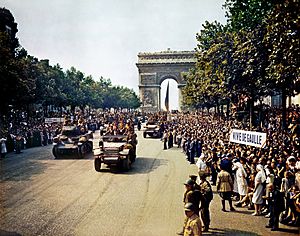
After Paris, Leclerc's division continued fighting. His two oldest sons, Henri and Hubert, who were 18 and 17, lied about their ages to join the 2e DB. They both served bravely in the division.
Strasbourg and the End of the War
Leclerc led his division to a notable victory in September 1944 at the Battle of Dompaire, where they defeated German tanks. He was praised by American generals for his skill.
On November 22, Leclerc received permission to advance on Strasbourg, fulfilling the "Oath of Kufra". His troops surprised the Germans and entered Strasbourg on November 25. That afternoon, the French flag flew over the Strasbourg Cathedral, just as he had promised.
The 2e DB continued to fight in France, helping to reduce the Colmar Pocket. In April 1945, they crossed the Rhine river into Germany and pursued German forces into Bavaria. Leclerc visited the Dachau concentration camp after it was liberated, seeing the horrors of the Nazi regime. For his great service, Leclerc was awarded the Grand Cross of the Legion of Honour.
Post-War Service in Asia
After World War II ended in Europe in May 1945, Leclerc was given command of the French Far East Expeditionary Corps. He represented France at the official surrender of Japan in Tokyo Bay on September 2, 1945. Later that year, he legally changed his name to Jacques-Philippe Leclerc de Hauteclocque, adding his famous wartime nickname.
Leclerc was tasked with taking back control of French Indochina (today's Vietnam, Cambodia, and Laos). During the war, Japan had taken control of this area. After Japan surrendered, the Vietnamese nationalist leader Ho Chi Minh declared Vietnam's independence.
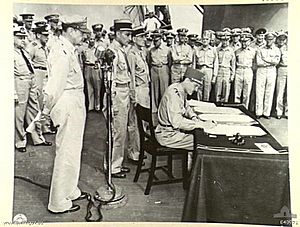
Leclerc arrived in Saigon in October 1945. He quickly realized that a political solution was needed in Indochina, not just military force. He believed that France should negotiate with Ho Chi Minh. In March 1946, an agreement was reached where France would recognize Vietnam as a free state within the French Union, and Ho Chi Minh would allow French soldiers to stay for five years.
However, this agreement was not fully supported by everyone. Some French officials wanted to keep full colonial control. Leclerc warned that fighting against communism would be useless unless the desire for national independence was addressed. He strongly advised, "Negotiate at all costs!" But his advice was not fully followed, and he was recalled to France in 1946.
Death and Legacy
On November 28, 1947, General Leclerc was killed in an airplane crash in French Algeria. His body was brought back to Paris and buried at Les Invalides, a famous military museum and burial site.
Leclerc was made a Marshal of France after his death on August 23, 1952. His marshal's baton and his famous kepi (military cap) are displayed at the Musée de l'Armée in Paris.
Today, a modern French battle tank, the Leclerc tank, is named after him. There are also many monuments and streets in France named in his honor, especially in Paris and other cities he helped liberate.
Images for kids
-
Monument in Aulnay-sous-Bois
-
Memorial plaque in Les Invalides, in Paris
-
Statue of Leclerc in Douala
-
Memorial tablet in Amiens Cathedral
See also
 In Spanish: Philippe Leclerc de Hauteclocque para niños
In Spanish: Philippe Leclerc de Hauteclocque para niños


